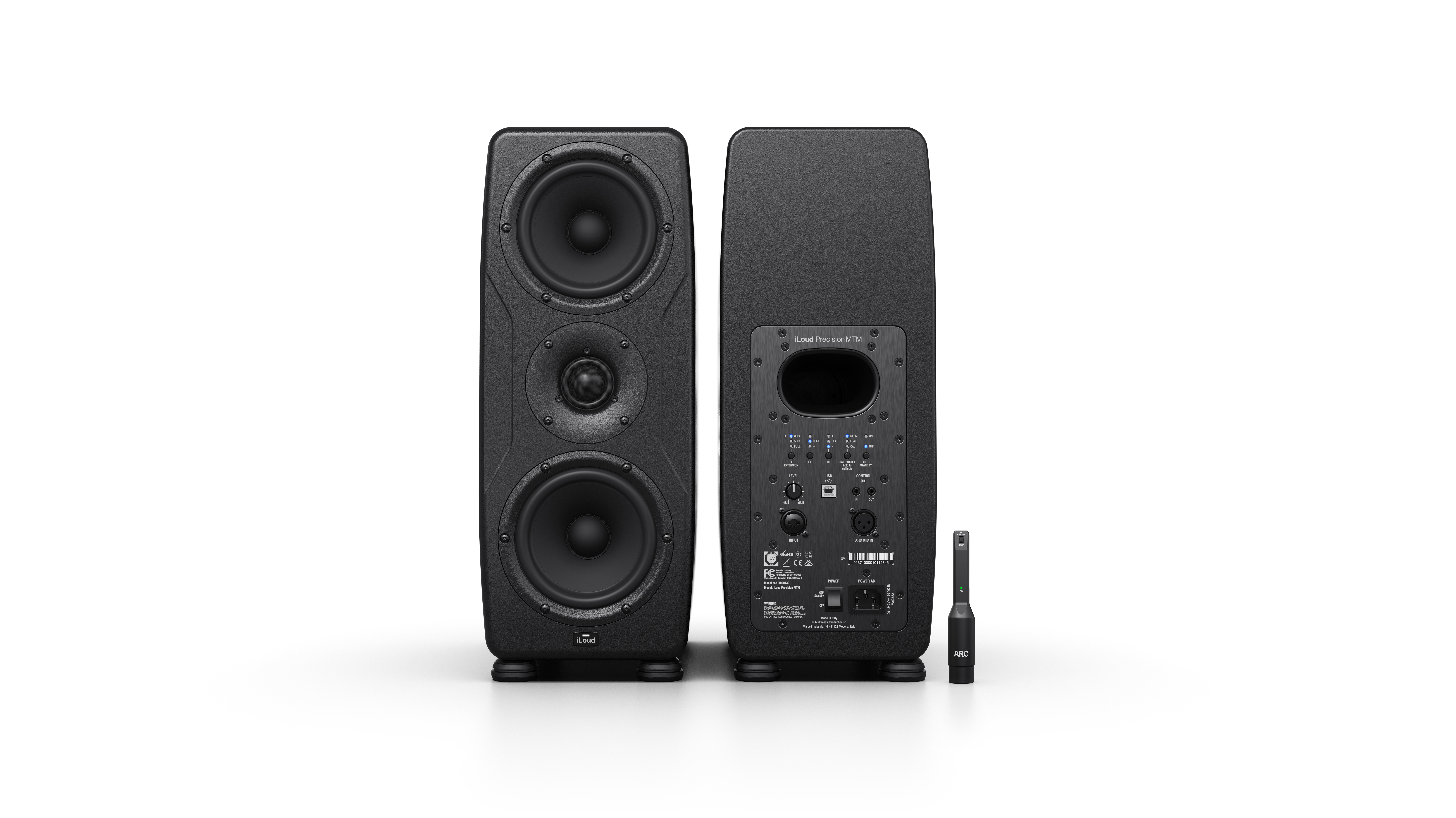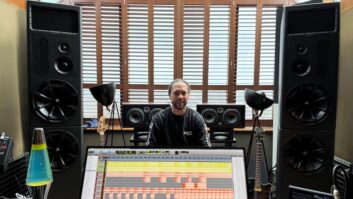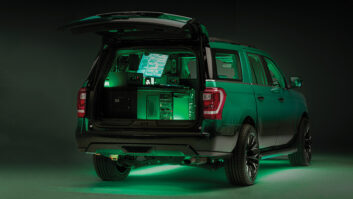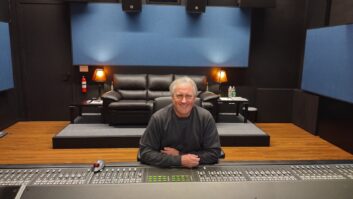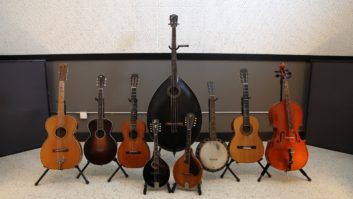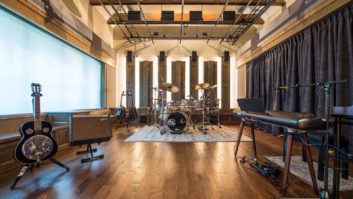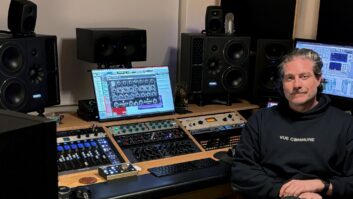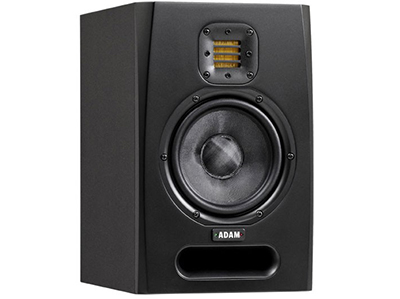
Mixing, recording and editing audio in tight spaces has never more prominent than right now. Home studios, tour buses, hotel rooms, editing suites and anywhere else high-end decisions are made are a perfect fit for the speakers in this month’s roundup of desktop monitors. The speakers listed here are active and less than 12 inches tall when oriented properly, meaning you can pack ‘em, ship ‘em, set them up, and quickly be ready for action in a mobile or installed environment such as an OB truck, edit suite, tour bus or hotel room. Note: There are a few models—such as the Avantone MixCubes, Pelonis Model 42, Emotiva Airmotiv 5, Equator D5, and others—that have been out a few years now, but are equally worthy.
ADAM F5
The F5 offers a stated frequency range of 52 Hz to 50 kHz, plus comprehensive control. The monitor is equipped with a Room Equalizer for high (>5 kHz) and low (<300 Hz) frequencies and an overall volume control on the rear panel. It also incorporates a highpass filter, to be used in conjunction with a subwoofer, and XLR/TRS/RCA inputs. Two Class-A/B amplifiers with 50 watts RMS/70W Music drive the F5, which helps the monitor to provide a vibrant, deep bass response and a maximum SPL of 106 dB per pair.
Alesis Elevate 5
Alesis Elevate 5 active studio speakers use technology adopted from Alesis’ award-winning Monitor One and M1Active professional studio monitors. Promising full lows, clean highs and a detailed stereo image, the speakers incorporate 5-inch woofers, 1-inch silk-dome tweeters and dedicated power amps, all housed in custom wood cabinets that are magnetically shielded. The Elevate 5s also include a built-in power supply, front panel volume control, a bass-boost switch, rear-mounted RCA jacks, a 1/8-inch stereo jack, and a single ¼-inch to ¼-inch cable.
ATC SCM25 Pro
The SCM25 Pro is a compact active three-way studio control monitor designed for positioning on a meter bridge, and also rack-mountable for broadcast applications. ATC’s soft dome outputs midrange frequencies, while the bass driver is hand-built in-house, using a carbon paper cone with high excursion capability. Onboard amplification features the company’s Class-A/B MOSFET output stage delivering 150W/60W/25W; all three stages are fed by 4th-order critically damped crossover filters with phase compensation.
Barefoot MicroMain45
The Barefoot MM45 is a three-way active monitor with controls for equalization contour and an input level stepped attenuator. The MM45 tweeter has a 1-inch ring radiator, advanced geometry motor, and rear waveguide chamber, with 180W Hypex amplifier. The midrange drivers have two 2.5-inch aluminum cones, advanced geometry motors, and ±2mm linear excursion, with 180W Hypex amplifier. The woofer has an 8-inch aluminum cone with high linearity motor, and ±13mm linear excursion with a 250W Hypex amplifier.
Behringer NEKKST K5
The 100W NEKKST K5 features separate amplifiers for the 5-inch glass-fiber woofer and 1-inch silk-dome tweeter, which are enhanced by designer Keith Klawitter’s Advanced Waveguide technology. K5’s rear panel features switches for adjusting high- and low-frequency response. Independently controlled limiters protect both the woofer and tweeter against overload. The K5 accepts XLR, TRS and unbalanced RCA connectors. Behringer also offers the Studio 50 USB 100-watt digital monitor speakers, which combine USB and analog connectivity in a bi-amped, 2-way speaker configuration.
Blue Sky eX02 satellite
The eXo2 from Blue Sky International is an active 2.1 desktop speaker system comprising a pair of two-way satellite speakers, a subwoofer and a desktop HUB remote. Each of the satellite speakers has a 3-inch cast-frame woofer with a neodymium motor structure and a 1-inch fabric neodymium tweeter. The remote HUB has two large knobs for controlling system gain and subwoofer level. The subwoofer houses the amplifier and connectors, and offers XLR/TRS combo inputs and a stereo RCA input. The subwoofer has an 8-inch paper cone to produce frequencies as low as 20 Hz.
Dynaudio BM5 Compact mkIII
The BM5 mkIII features an extended-excursion 7-inch woofer with pure aluminum voice coil, 1.1-inch soft dome tweeter with pure aluminum voice coil, 50W LF and 50W HF RMS Class-D amplifier with DSP crossover, 118dB SPL peak power output, input sensitivity switch (-10/+4dB range), a stated frequency response of 42 to 24k Hz, and extended bass with BM9S II or 14S II precision subwoofers. Its HF, MF, LF analog room filters allow for flexible positioning, and highpass filters at 60/80Hz provide for subwoofer adaption.
Event 20/30
The 20/ 30 monitor combines three discrete drivers with a new waveguide assembly to house the speaker’s midrange and high frequency drivers, as well as optimize audio dispersion and power response characteristics. For the critical midrange, a 3.5-inch cone transducer was engineered using a pressed pulp and polypropylene cone, combined with an optimized magnetic circuit. The driver is loaded onto a shallow waveguide that results in increased sensitivity and output while generating very low distortion artifacts.
Focal Twin 6 Be
The Twin6 Be is part of Focal Professional’s SM6 line. One of the two 6.5-inch woofers works in the mid-low band, whereas the other reproduces from 40 to 150 Hz. This creates a bass that preserves all the signal dynamics, without any masking effect in the midrange. The Twin6 Be can be installed vertically or horizontally to respond to the space requirements of each studio.
Fostex PX-5
The PX-5 is a two-way active monitor offering a stated frequency response of 20 to 20k Hz (±2dB), and is equipped with 5.2-inch woofer and 1-inch tweeter powered by digitally controlled 35W and 18W power amplifiers, respectively. The speakers use a FIR-type “Digital Network Filter” that is designed to ensure linearity. Each speaker includes a 0.3dB-step tweeter level control, an incremental LF roll-off adjustment and an overall level control.
Genelec 8320A
The compact 8320A Smart Active Monitor includes Genelec Loudspeaker Manager (GLM Version 2) control network and software, which allows adjustments of all aspects of monitor settings and full system control. Genelec AutoCal automatically aligns every monitor for level, timing and equalization of room response anomalies. The 8320A features Genelec MDE and DCW technologies, a flow optimized reflex port and reportedly very neutral frequency response.
Gibson Les Paul Reference Monitors LP4
With its unmistakable front panel woodwork, Gibson’s Les Paul Reference Monitor Series is offered in three models, all featuring carbon-coated titanium tweeters, non-woven carbon woofers and Class-D amplification power; the LP4 sports a 1-inch diamond-like carbon-coated titanium tweeter and a 4-inch midrange woofer. The monitors feature a two-way, bi-amped design, and include high, midrange and low EQ knobs, balanced XLR and unbalanced RCA inputs, and wood veneer fronts that recall the long-running Gibson Les Paul electric guitar.
JBL LSR305
JBL Professional’s 3 Series studio monitors incorporate JBL’s patent-pending Image Control Waveguide found in its flagship M2 Master Reference Monitor. The LSR305 promises a response of 43 to 24k Hz and a peak SPL of 108 dB. With a complex contour employing engineered ridges, the waveguide optimizes the phase relationship of the loudspeakers, and also the blend of directed and reflecting sound arriving at the listening position. The 3 Series’ long-throw woofer and its damped woven composite tweeter are designed to reproduce the powerful transients and micro dynamics of any mix.
KRK ROKIT 5 G3
KRK’s ROKIT 5 G3 powered monitors include a 1-inch soft dome tweeter and 5-inch glass-Aramid composite woofer. The G3 delivers highs up to 35 kHz, vocal clarity and extended bass response. The proprietary bi-amped, Class-A/B amplifier grants SPL up to 106 dB. The ROKIT waveguide is designed to ensure detailed imaging in the listening position. The front-firing bass port reduces boundary coupling to allow flexible positioning in the room while the engineered surface reduces diffraction distortion.
M Audio BX5 Carbon
The BX5 Carbon studio monitor offers 80W Class-A/B bi-amplification and is equipped with a 5-inch woven Kevlar LF driver and 1-inch natural silk dome tweeter. The tweeter’s waveguide has been enhanced to provide an expansive sweet spot and superior stereo imaging. Pinhole-mounted LED placement cues help locate and light up the sweet spot to ensure proper speaker placement. The BX5 Carbon’s Acoustic Space Control, a series of calibration switches, helps provide optimal acoustic conditions for tracking, mixing and monitoring anywhere.
Mackie MR5mk3
Mackie’s MR5mk3 powered monitors sport an enhanced waveguide system that minimizes diffraction and reflections to yield a wider sweet spot. Offering 50 watts of Class-A/B amplification matched to the 5.25-inch polypropylene woofer and 1-inch silk-dome tweeter, the MR5mk3 delivers high output with controlled low-frequency performance. Mackie MRmk3 Series monitors provide two levels of bass boost, plus a boost/cut for high frequencies, so users can fine-tune the speakers’ frequency response to a specific room. The MR5mk3 also has balanced XLR and TRS connectors, plus an RCA.
Neumann KH120 Digital
Based on the KH 120 A launched in 2010, the KH 120 D is equipped with an additional BNC input for AES/EBU or S/PDIF formats (24-bit/192 kHz). The KH 120 D also features digital delay for both analog and digital inputs, enabling the monitor to be used for demanding tasks requiring time alignment, with a maximum delay of more than 400 ms. It features a Mathematically Modeled Dispersion waveguide flexible acoustical controls, analog Class-A/B amplifiers, analog and digital input formats, and a range of mounting hardware.
PMC twotwo.5
The twotwo Series models are true compact reference monitors with ATL bass loading technology. All models are designed and built in Britain, and share the same core design and features; the model number refers only to the approximate size (in inches) of the bass driver, with larger numbers denoting increasing cabinet volume, greater bass extension and higher SPL capabilities. The twotwo.5 is 11.65 inches high and 6.1 inches wide, and offers consistent response in either vertical or horizontal orientation. It has twin Class-D amplifiers.
PreSonus Eris E5
The compact Eris E5 has a 5.25-inch, Kevlar low-frequency driver, mated with a 45W Class-A/B amplifier; and a 1-inch silk-dome tweeter powered by a 35W, Class-A/B amplifier. It generates a peak 102dB SPL. Frequency response is rated at 64 Hz to 22 kHz. Eris models have individual balanced XLR and ¼-inch TRS input connections in addition to unbalanced RCA inputs. A four-position Acoustic Space switch controls a second-order shelving filter, centered at 800 Hz, that provides three attenuation points, allowing users to control the bass response. A highpass switch sets the low-frequency cutoff to be flat, 80 Hz, or 100 Hz.
Quested S6R
Designed to partner with the SB10R subwoofer in a three-way system, the S6R is easy to position where space is limited, and offers a low frequency response that is more than adequate for many applications. When an extended bass response is required, the infinite baffle cabinet design facilitates perfect integration with SB10R subwoofer, which Quested states will extend the frequency response down to 25 Hz.
Samson Media Resolv RXA5
The RXA5 employs a bi-amplified design, ensuring dynamic headroom and reducing intermodulation distortion. The monitor is constructed of solid MDF with a vinyl-wrapped finish. At the core of the RXA5 (70 watts, 50 to 27k Hz) is Samson’s newly developed Air Displacement Ribbon Tweeter. The 2.5-inch aluminum tweeter’s corrugated ribbon design is said to be able to move four times the air of a standard dome tweeter. The speaker’s 5-inch copolymer woofer with butyl coating forces a fast recovery and quick transient response for tight, low-end performance.
Sonodyne SRP 500
The SRP 500’s enclosure is made of pressure die cast aluminum, and the silk dome tweeter is nested in a custom waveguide to produce on- and off-axis linearity and a wide, detailed soundstage. A new 50+50W bi-amplifier drives the transducers (5.25-inch Kevlar woofer); maximum SPL is measured at 104 dB. DSP with high quality AD/DA is employed for the crossover and also provides the 0.75dB step calibrated HF and LF room compensation EQs at the rear. The SRP 500 accepts both XLR and TRS balanced inputs.
Tannoy Reveal 502
The powered Reveal 502 monitor’s 75-watt bi-amplified module and active crossover filter ensure maximum power and tonal clarity from its 5-inch LF driver and 1-inch soft-dome “Poke-Resistant” tweeter, along with adjustable volume and EQ controls, and balanced and unbalanced inputs. The rear panel has an Independent gain control, along with an HF trim control, to allow fine-tuning. Its tuned front-firing bass port allows near-wall placement and ensures optimal LF performance.
Trident HG3
The midrange HG3 speaker is mounted in an isolated, 6-inch diameter, damped, inert cylinder, with a ½-inch closed-cell wall thickness, to eliminate edge diffractions and woofer interaction. The cylinder also houses the 1-1/8 inch silk dome tweeter, its crossover (set at 320 Hz and 3,500 Hz), plus the midrange and tweeter level controls. A separate 60W amplifier drives the cylinder midrange and treble components. The Trident HG3 power amplifier section is made up of three high-powered MOS amplifier modules, noted for their low distortion, wide bandwidth and low noise levels.
Yamaha HS5
All HS Series full-range models are two-way bass-reflex bi-amplified and feature a new high-resolution 1-inch dome tweeter designed for extended high-frequency response with very low distortion up to 30 kHz. Also equipped with a newly designed, high-power woofer, HS Series monitors deliver clearly defined bass even at high output levels. HS monitors also offer room-control and high-trim response controls that let users tailor the monitors to the room for optimal response. XLR and TRS phone jack inputs accept balanced or unbalanced signals.
